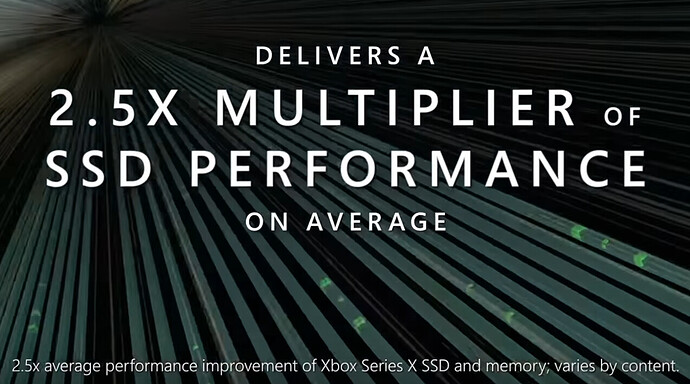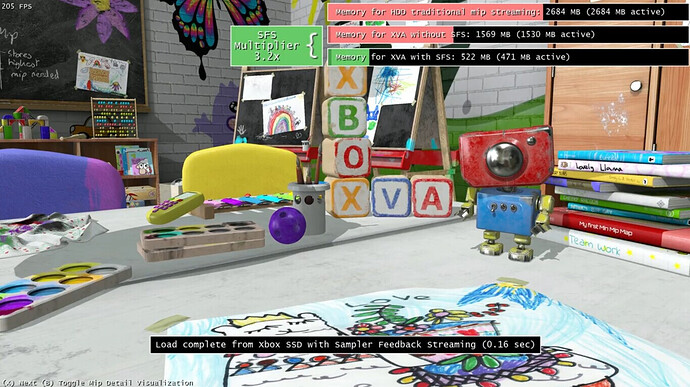XSX could absolutely do what Ratchet and Clank does. The PS5 fanboys went quite about that exact thing because Fortnite had the exact same thing with their rifts, and it was possible on PS4 and Xbox One hard drives.
You can swap from Game A to Game B in about 6 seconds (from gameplay to gameplay I should add) with quick resume so loading more of the same game in less time is obviously possible.
And that includes writing out memory to NVME, which is slower speed than reading, and then reading in the new game. So for nextgen games that’s Writing 13.5 GB then Reading 13.5 GB.
As mentioned that also includes writing the existing RAM contents to storage. So you can pretty much assume it takes half that time to fill up your RAM from storage. 3 seconds. To fill 13Gb of RAM available to games with a drive that’s “only” 2.4GBps fast tells us that they’re leveraging things like hardware compression/decompression.
But again that’s much different than loading in a game.
Oh I’m sure it could hit those speeds when delivering assets and I’m sure the PS5 could do even better When it comes to raw speeds.
But again there’s a bit more than loading assets involved in a game situation. Technically the PS5 should be able to fill up game RAM in 1.5 seconds with compressed data. So you think things would be faster in R&C. But because it’s doing a lot more than streaming in assets it takes more time and is held back by the CPU doing some work and so on.
My point was to point out that what they are doing there in R&C, streaming in a ton of assets, takes a fraction of the time compared loading a level from scratch or loading a game from scratch because of things like creating data structures and all of the variables that your game will have. But I didn’t mean to imply the complete absence of it, there is still a bit of that stuff. The new level will still have enemies with health, their own AI, etc.
A good example is the recent optimization of Grand Theft Auto V Online’s loading. I forget the details but it sounds like there was a file being parsed that listed all of the DLC available and parsing that file took a lot of time. It had nothing to do with the transfer of data from storage to RAM but it was a bunch of work the CPU had to do. Someone optimized that process and the mode apparently loads much faster now.
This is why I feel some people underestimate Velocity Architecture. Loading in video games is much more than simply your drive speed. Drive speed absolutely helps and opens new doors to developers when it comes to streaming in assets, but when it comes to loading games from scratch there are a few other considerations.
In a nutshell what I’m saying is that the PS5s SSD will afford it to load assets in much faster than on the Xbox, but the Xbox going to have comparable load times because there’s more to loading a game than bringing in assets. Maybe I’m not making the difference between stream and load clear here, sorry about that.
Fan boys will take anything and run for declaring victory.
I really don’t see advantage because the games which will use PS5 SSD are most likely going to be the exclusive anyway on PS5 so what’s the point of being unique.
The best thing the SSD could be used and i believe is the most important thing about it is that it will save a huge time in playstation 5 games development.
We may see a paradigm shift where games like tlou2 took 7 years in making are being developed in just 2-3 years.
Same goes for xbox first party stuff on next gen only.
No explanation required after this statement
We have that now with Avengers, which the developers said to reworked loading completely taking advantage of the new apis and were able to reduce loading times to a mere 4-6s.
However, we are still not sure if they are using all of the tech available on SX (SFS for example, is seemingly not GA yet)
This.
Loading game is not about RAW transfer speed or bandwidth. It’s about delivering at right time. This where SFS becomes the most critical part of XVA.
To make things possible instantly, we have to deal with milliseconds. A frame time is 16.67 milliseconds. Even 4 milliseconds is like 25% of all the budget.
It’s definitely possible, we now have one game (Avengers) where the developer said most of the time porting it was to rework the entire loading pipeline to make use of all the low level IO apis on both consoles. And that game loads from the main menu to ingame in less than 6 seconds (versus 5 on PS5) on SX without using SFS.
Proportionally speaking that would translate to 3.6s for SX to load Ratchet compared to 3s on PS5, an insignificant delta. And with SFS they could even shave more from that, perhaps even outperforming it.
Even that is a bit foggy since ‘assets’ isn’t as clear as it used to be once SFS or even ML (for upres textures @ runtime) is involved. The size of the comparable on screen asset can vary a ton between the two systems.
I do want to point out SFS is only useful for textures, so the 2-2.5x SSD bandwidth multiplier isn’t going to apply to everything.
SFS does only apply to textures however iirc the we dunno what the 2.5x figure refers to specifically. James Stanard said SFS nets you a factor of 3+ for texture streaming, and if textures take up 70% of streaming needs (which is a common figure used) it might be that the reported 2.5x figure from MS is actually accounting for the entire I/O.
Ex. Using a factor of 3.1 for textures alone (and assuming 70% texture/other split) gets you right at 2.5x overall.
This is what Jason Ronald says in his old Xbox Wire post:
“Through specialized hardware added to the Xbox One X, we were able to analyze texture memory usage by the GPU and we discovered that the GPU often accesses less than 1/3 of the texture data required to be loaded in memory.”
^^^This correspond directly what Stanard’s claim about 3+ factor for textures. Ronald also says this:
“This innovation results in approximately 2.5x the effective I/O throughput and memory usage above and beyond the raw hardware capabilities on average. SFS provides an effective multiplier on available system memory and I/O bandwidth, resulting in significantly more memory and I/O throughput available to make your game richer and more immersive.”
Notice how in this blurb here he shifts from specifically talking about texture streaming to more broadly talking about I/O and RAM usage, so I’m pretty confident the 2.5x figure actually refers to the whole I/O under the assumption of a 70% texture/other split. Note: The 70% figure as a typical use case is also one from Stanard iirc.
But textures are a significant part of the total memory budget. And with engines like UE5 (static) geometry is also encoded in textures.
True, but it’s worth mentioning that loading vertex data as texture isn’t impossible, the UE5 demo relied a lot on that for example. So, in practice, for a next gen game developed on the completely new paradigm we might reach close to 100% of the data loaded being stored in an texture like format.
Didn’t know that about UE5’s handling of geo. Huh. Interesting!
It actually doesn’t appear to be true. If ya do the math it appears 2.5x figure is for the whole I/O in a typical use case. Not to mean all I/O gets the boost, but 2.5x reflects the weighted average accounting for non-texture streaming data too. The stuff about UE is real interesting.
Oh, you are absolutely right. As the demo they displayed on SS announcement illustrates, they get 2.5-3x less data in memory compared to not using SFS, so that’s indeed how much less data it’s loaded all things already considered.
Do you have that demo video of SFS handy? I couldn’t remember what to search for to find it, lol.
EDIT: While looking for it, I also found an old IGN interview Ronald does where he talks about SFS offering “an overall multiplier” for throughput and RAM.
Also found this, which also suggests it is 2.5x for the overall throughput:
Found screen grab of the SFS tech demo I was looking for too:
Also this is from Goosen’s interview with DF:
“So if a game never had to load pages that are ultimately never actually used, that means a 2-3x multiplier on the effective amount of physical memory, and a 2-3x multiplier on our effective IO performance.”
^^Bit more vague there.
PS5 will load faster due to raw specs and if its used to its potential. But I don’t really care. Loading will be super fast on Series Consoles regardless.
The raw spec isn’t what matters. Effective throughput is. SFS is the big card XSX has yet to play here as no games utilize it yet.
Agreed. Scarey thing is no game has used SFS, Mesh Shaders, ML and very few have used VRS. There is a ton of optimization headroom in the XSX.

